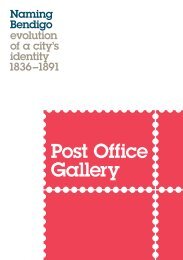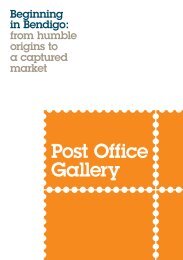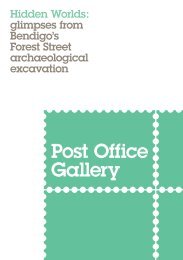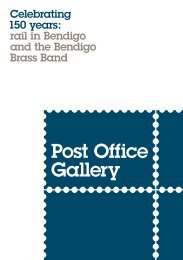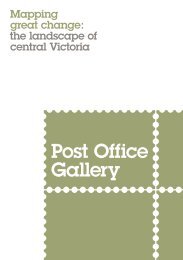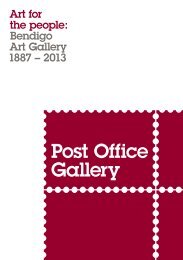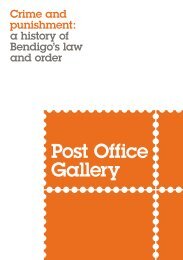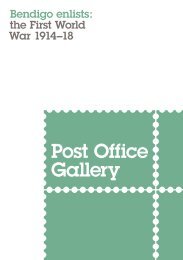Theatrical traditions: stage and screen in Bendigo
This electronic publication accompanies the exhibition Theatrical traditions: stage and screen in Bendigo. Western theatrical traditions came to Bendigo with fortune seekers in the 1850s. Since then, everything from amateur to professional, Shakespeare, opera, live music, eisteddfods, Vaudeville, musicals and comedy have graced the many stages in Bendigo. The beginning of the 20th century heralded the dawn of the motion picture, which by the middle of the century was the most popular form of entertainment. Existing Bendigo theatres quickly adapted and numerous purpose built picture theatres were constructed. Theatrical traditions: stage and screen in Bendigo looked at key moments, venues and people in the evolution of such entertainment in Bendigo.
This electronic publication accompanies the exhibition Theatrical traditions: stage and screen in Bendigo.
Western theatrical traditions came to Bendigo with fortune seekers in the 1850s. Since then, everything from amateur to professional, Shakespeare, opera, live music, eisteddfods, Vaudeville, musicals and comedy have graced the many stages in Bendigo. The beginning of the 20th century heralded the dawn of the motion picture, which by the middle of the century was the most popular form of entertainment. Existing Bendigo theatres quickly adapted and numerous purpose built picture theatres were constructed. Theatrical traditions: stage and screen in Bendigo looked at key moments, venues and people in the evolution of such entertainment in Bendigo.
Create successful ePaper yourself
Turn your PDF publications into a flip-book with our unique Google optimized e-Paper software.
8<br />
First Benefit on<br />
S<strong>and</strong>hurst of the<br />
sisters Ada &<br />
Fanny Hart at the<br />
Lyceum Theatre,<br />
theatre ticket<br />
1869<br />
lithographic pr<strong>in</strong>t<br />
Collection Rod<br />
Aikman<br />
Image courtesy<br />
Douglas Stewart<br />
F<strong>in</strong>e Books<br />
Photograph<br />
Tira Lewis<br />
time. Unlike the variety enterta<strong>in</strong>ment<br />
that was common at establishments like<br />
the Shamrock, the Lyceum’s program<br />
<strong>in</strong>cluded opera, Shakespeare <strong>and</strong> other<br />
plays from the English repertoire<br />
attract<strong>in</strong>g a more cultured audience.<br />
Ch<strong>in</strong>ese opera was also performed<br />
annually at the Lyceum, often <strong>in</strong> aid<br />
of the Asylum or Hospital. 13 Despite<br />
its reputation <strong>and</strong> achievements, <strong>in</strong><br />
1872, like those before it, the Lyceum<br />
closed.<br />
ST JAMES’ HALL<br />
In the 1870s with the clos<strong>in</strong>g of<br />
the Lyceum <strong>and</strong> the <strong>in</strong>creas<strong>in</strong>g<br />
sophistication of theatre-goers, there<br />
was grow<strong>in</strong>g concern about the need<br />
for a first-class theatre worthy of a city<br />
such as <strong>Bendigo</strong>. Heffernan’s solution<br />
was to build St James Hall on a narrow<br />
site directly opposite The Shamrock<br />
Hotel. 14 The <strong>Bendigo</strong> Philharmonic<br />
Society opened the hall on 8 April<br />
1873 with a performance of H<strong>and</strong>el’s<br />
Judas Maccabeus. 15 The venture was<br />
short lived however, as Heffernan put<br />
his energy <strong>in</strong>to the construction of the<br />
Royal Pr<strong>in</strong>cess Theatre just up the hill<br />
on View Street.<br />
THE ROYAL PRINCESS THEATRE<br />
The Royal Pr<strong>in</strong>cess Theatre opened<br />
on 31 August 1874 with a performance<br />
of The Gr<strong>and</strong> Duchess of Gerolste<strong>in</strong> just<br />
months after its Paris premier. 16 Situated<br />
on View Street, the theatre was designed<br />
by Vahl<strong>and</strong> <strong>and</strong> Getzschmann. 17 With<br />
a seat<strong>in</strong>g capacity of 2000 spread across<br />
three levels <strong>and</strong> six <strong>stage</strong> boxes, its scale<br />
<strong>and</strong> elegance rivaled capital city theatres<br />
<strong>and</strong> successfully satisfied community<br />
aspirations for a premium theatre.<br />
In the late 19th <strong>and</strong> early 20th centuries<br />
everyth<strong>in</strong>g from vauderville to classical<br />
theatrical productions, pantomimes,<br />
vocal <strong>and</strong> music recitals, opera, ballet<br />
<strong>and</strong> elocutionary competitions were<br />
presented on the Royal Pr<strong>in</strong>cess’ <strong>stage</strong><br />
with a constant stream of reputed local,<br />
national <strong>and</strong> <strong>in</strong>ternational artists <strong>and</strong><br />
tour<strong>in</strong>g companies to susta<strong>in</strong> them.<br />
Many well-known performers stopped<br />
off <strong>in</strong> <strong>Bendigo</strong> to perform at the Royal<br />
Pr<strong>in</strong>cess Theatre on their Australian<br />
tours. 18<br />
One such celebrity was Dame Nellie<br />
Melba who performed <strong>in</strong> <strong>Bendigo</strong> on<br />
several occasions. Her first visit was <strong>in</strong><br />
February 1889, her second <strong>in</strong> 1908.<br />
Dur<strong>in</strong>g this second visit, like many<br />
of her colleagues, Melba stayed at the<br />
most reputable accommodation of<br />
the day, the Shamrock Hotel. Legend<br />
has it that she was so irritated by the<br />
constant chim<strong>in</strong>g of the Post Office<br />
clock opposite her w<strong>in</strong>dow, she asked<br />
for the clock to be stopped so she could<br />
get some sleep. Her last appearance<br />
<strong>in</strong> <strong>Bendigo</strong> was a farewell concert at






